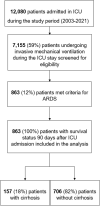Outcomes and time trends of acute respiratory distress syndrome patients with and without liver cirrhosis: an observational cohort
- PMID: 37773241
- PMCID: PMC10541379
- DOI: 10.1186/s13613-023-01190-1
Outcomes and time trends of acute respiratory distress syndrome patients with and without liver cirrhosis: an observational cohort
Abstract
Background: In studies prior to lung-protective ventilation, liver cirrhosis in acute respiratory distress syndrome (ARDS) was associated with high mortality rates. Since patients with cirrhosis have been excluded from many trials on ARDS, their outcome when treated with lung-protective ventilation is unclear. The objectives were to assess whether cirrhosis is associated with mortality in ARDS and trends over time in mortality and severity.
Methods: We conducted a retrospective analysis of a prospective observational cohort conducted in a 20-bed tertiary ICU from October 2003 to December 2021. All consecutive adult critically ill patients with ARDS were included. ARDS was defined by the Berlin criteria. The primary outcome was 90 day mortality, assessed with Kaplan-Meier curves and multivariate Cox analysis. Time trends were assessed on 90 day mortality, Sequential Organ-Function Assessment score (SOFA) and non-hepatic SOFA. Ventilation settings were compared between patients with and without cirrhosis.
Results: Of the 7155 patients screened, 863 had a diagnosis of ARDS. Among these ARDS patients, 157(18%) had cirrhosis. The overall 90 day mortality was of 43% (378/863), 57% (90/157) in patients with cirrhosis and 41% (288/706) in patients without cirrhosis (p < 0.001). On survival curves, cirrhosis was associated with 90 day mortality (p < 0.001). Cirrhosis was independently associated with 90 day mortality in multivariate analysis (hazard ratio = 1.56, 95% confidence interval 1.20-2.02). There was no change in mortality over time in ARDS patients with and without cirrhosis. SOFA (p = 0.04) and non-hepatic SOFA (p = 0.02) increased over time in ARDS patients without cirrhosis, and remained stable in ARDS patients with cirrhosis. Tidal volume, positive end-expiratory pressure, plateau pressure and driving pressure were not different between ARDS patients with and without cirrhosis.
Conclusions: Although ARDS management improved over the last decades, the 90 day mortality remained high and stable over time for both ARDS patients with (57%) and without cirrhosis (41%). Nevertheless, the severity of patients without cirrhosis has increased over time, while the severity of patients with cirrhosis has remained stable.
Keywords: Acute respiratory distress syndrome; Cirrhosis; Intensive care unit; Liver failure; Ventilation.
© 2023. La Société de Réanimation de Langue Francaise = The French Society of Intensive Care (SRLF).
Conflict of interest statement
Pr. Jaber reports receiving consulting fees from Drager, Medtronic, Baxter, Fresenius-Xenios, Mindray, and Fisher & Paykel. Dr. De Jong reports receiving consulting fees from Medtronic, Dräger, Viatris and Fisher & Paykel. No conflict of interests is reported for other authors.
Figures




References
-
- Bellani G, Laffey JG, Pham T, Fan E, Brochard L, Esteban A, et al. Epidemiology, patterns of care, and mortality for patients with acute respiratory distress syndrome in intensive care units in 50 Countries. JAMA. 2016;315(8):788–800. - PubMed
-
- De Jong A, Cossic J, Verzilli D, Monet C, Carr J, Conseil M, et al. Impact of the driving pressure on mortality in obese and non-obese ARDS patients: a retrospective study of 362 cases. Intensive Care Med. 2018;44(7):1106–1114. - PubMed
-
- Pensier J, de Jong A, Hajjej Z, Molinari N, Carr J, Belafia F, et al. Effect of lung recruitment maneuver on oxygenation, physiological parameters and mortality in acute respiratory distress syndrome patients: a systematic review and meta-analysis. Intensive Care Med. 2019;45(12):1691–1702. - PubMed
-
- Matuschak GM, Shaw BW., Jr Adult respiratory distress syndrome associated with acute liver allograft rejection: resolution following hepatic retransplantation. Crit Care Med. 1987;15(9):878–881. - PubMed
-
- Monchi M, Bellenfant F, Cariou A, Joly LM, Thebert D, Laurent I, et al. Early predictive factors of survival in the acute respiratory distress syndrome. A multivariate analysis. Am J Res Crit Care Med. 1998;158(4):1076–1081. - PubMed
LinkOut - more resources
Full Text Sources

